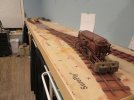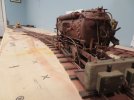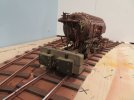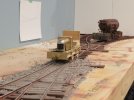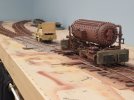michael mott
Western Thunderer
Now that the 12 foot by 2 foot baseboard has been completely stripped, I have begun playing with some ideas. being a confirmed "rubber gauger" and by that I mean that I am not really committed to any particular gauge for a long term. I am often envious of those of you who can build fantastic layouts and or dioramas that might take years to complete. My models take a long time for completely different reasons, I end up running out of steam on any particular project for a while and pick up one of the other earlier ones. This process seems to be the pattern that I have over the last 50 years or so fallen into. This probably came out of the years that I worked professionally building all sorts of models in all sorts of scales and genres, from architectural to design prototypes , and movie props.
Be that it may it is a cross I have to bear. At 70= years I really don't see me turning a "new leaf" at this point in my model making hobby and or life.
Which leads me to my new layout
I had made a comment on Alan's "Blackney A glimpse of the forest" layout about trees.
In my back yard I have a medium sized Amur Maple tree and some of the tips of it die off and look like miniature trees.


I rented one of those extended tree pruning loppers and cut off as many as I could reach. Thes were then hauled into the garage for analysis as potential trees.

A bunch of small scrap plywood bases were used to stand up the best examples after a bit of clipping and shaping.

One ca clearly see my affliction of "rubber gauging" a few 1:20.3 figures behind some Peco O gauge track and some Lima coaches awaiting some "work" they might get included aka the 1950's version of the Ruslip Miniature Railway which was my "genesis" induction into the world of railways as a 4 year old. One or two might wind up behind this once Lima F3 loco which over the last 17 years has morphed into a pretend P2

And with a 1/12 driver the loco is set up with a Chris Rennie Locoremote mini B running nicely on 3 AA batteries.

Currently it looks like this, A lot of the plastic has been replaced with some .020 hand sawn brass sheet. I take my hat off to all of you who put brass etched kits together.

So now that I've spilled the beans I will select a few of these "trees"



It could all change tomorrow though, I go to see the surgeon about the Carpal Tunnel situation.
And finally

The layout might be close to the processing shed near Verner's Bog. Time to look at dressing up some of these "trees"
Michael
Be that it may it is a cross I have to bear. At 70= years I really don't see me turning a "new leaf" at this point in my model making hobby and or life.
Which leads me to my new layout
I had made a comment on Alan's "Blackney A glimpse of the forest" layout about trees.
In my back yard I have a medium sized Amur Maple tree and some of the tips of it die off and look like miniature trees.


I rented one of those extended tree pruning loppers and cut off as many as I could reach. Thes were then hauled into the garage for analysis as potential trees.

A bunch of small scrap plywood bases were used to stand up the best examples after a bit of clipping and shaping.

One ca clearly see my affliction of "rubber gauging" a few 1:20.3 figures behind some Peco O gauge track and some Lima coaches awaiting some "work" they might get included aka the 1950's version of the Ruslip Miniature Railway which was my "genesis" induction into the world of railways as a 4 year old. One or two might wind up behind this once Lima F3 loco which over the last 17 years has morphed into a pretend P2

And with a 1/12 driver the loco is set up with a Chris Rennie Locoremote mini B running nicely on 3 AA batteries.

Currently it looks like this, A lot of the plastic has been replaced with some .020 hand sawn brass sheet. I take my hat off to all of you who put brass etched kits together.

So now that I've spilled the beans I will select a few of these "trees"



It could all change tomorrow though, I go to see the surgeon about the Carpal Tunnel situation.
And finally

The layout might be close to the processing shed near Verner's Bog. Time to look at dressing up some of these "trees"
Michael


















































